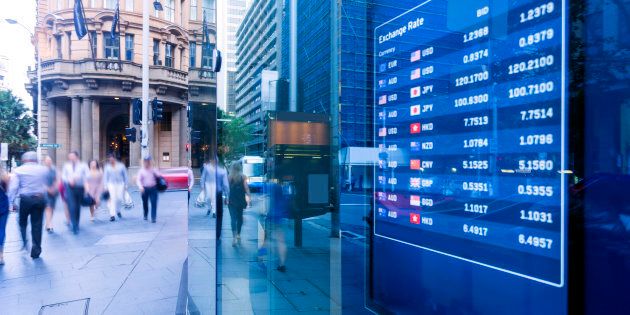
It is tempting for people to cheer for their national currency, just as we barrack for our national sports teams.
If the Aussie dollar is up, it must be because the world loves us. Indeed, politicians often cite 'positive market sentiment', exemplified by a rising currency, as some sort of endorsement of national economic management.
In reality, however, a soaring currency is nothing to celebrate. Sure it makes a trip to Bali a bit cheaper.
But for most Australians, it undermines the odds they'll have a decent job with which to pay for that holiday. And the dangers of an overvalued currency are especially acute at this moment in history, with the economy still seeking firm ground after the mining boom.
Since May, the Australian dollar has climbed almost 10 percent against the U.S. dollar, and is up strongly against most other currencies, too. Last week it burst through the 80-cent U.S. barrier. Worse yet, financial speculators (who buy the dollar purely in hopes it will increase in value, not because they need it to actually buy anything) are getting in on the action. That will push the dollar even higher in coming months -- some suggest to 85 cents U.S. or higher.
An overvalued currency makes Australian-made products (both merchandise and services) look more expensive in the eyes of foreign customers -- and conversely makes imports artificially cheap.
That means we export less, and import more. Whether that saves us any money at K-Mart (where it's hard to find anything made in Australia) is doubtful, importers and retailers pocket most of the savings from a higher dollar.
There's no doubt a soaring currency will do major damage to Australia's export industries, especially the non-resource sectors that are so important for post-mining-boom rebalancing.
Australia's long-standing international payments deficit, which has already piled up into a $1 trillion foreign debt, can only get worse as the rising dollar whacks national competitiveness.
Manufacturing, for example, is especially vulnerable to currency swings. At a normal exchange rate (say, 70 cents U.S. or lower), Australian costs are fully comparable to those in other industrial countries (including the U.S. and Europe); thus Aussie factories have a chance to survive in global markets.
The more the dollar rises, however, the less competitive domestic manufacturing becomes -- not because of poor efficiency or quality, but solely because a volatile financial indicator is pricing us out of the game.
After all, it was back when the dollar soared above par with the U.S. greenback (in 2012 and 2013) that the decisions were made to shut down the entire auto industry. Many other factories closed, too.
More recently, Australian manufacturing has been showing hopeful signs of a rebound (led by a 25 percent expansion in manufactured exports since 2010). That will be snuffed out, however, if the dollar continues to take flight.
It's not just manufacturing that suffers from an overvalued dollar. Other export-oriented industries face declining foreign sales, declining profit margins, or both. Even tradeable services are affected, as Australian suppliers start to look too expensive, like transportation, business, tourism, and overseas education.
Australia's long-standing international payments deficit, which has already piled up into a $1 trillion foreign debt, can only get worse as the rising dollar whacks national competitiveness.
Economists use a benchmark called 'purchasing power parity' to estimate fair value for currencies, based on overall price levels in different countries. Market exchange rates fluctuate daily; foreign exchange markets are a trillion-dollar-a-day casino where hedge funds and other punters make enormous bets on momentary fluctuations.
But, purchasing power parity should normally act as a centre of gravity for exchange rates, if a country's products are to be fairly valued in world trade.
By this marker, the Aussie dollar should settle in the range of 65-70 cents U.S., according to estimates published by the Organisation for Economic Cooperation and Development. But, when an exchange rate is pushed far off that benchmark for long periods of time, trade and investment patterns are distorted, and the whole economy suffers.
MORE ON THE BLOG:
Australia's Real Economic Woes Are Being Missed In The Surplus Of Debate About Good And Bad Debt
There are several factors behind this latest surge in the dollar.
The U.S. dollar declined after softer words from the U.S. Federal Reserve regarding future interest rate hikes -- and also because of Donald Trump's failure to implement any of his economic agenda.
Here at home, the Reserve Bank keeps interest rates higher than virtually any other industrial country, despite domestic weakness, and has all but ruled out future cuts (fearing they would fuel the housing bubble).
Hot foreign money continues to flow into Australia, buying property and bonds alike. Recent upswings in commodity prices (like iron ore) have also whetted speculators' appetites.
It's important for policy-makers to swim against these speculative tides, and try to prevent another round of currency-driven industrial dislocation. This will require more explicit warnings from them about the dangers of overvaluation, and a willingness to act as needed to keep the dollar in check.
For example, working together the Reserve Bank of Australia and the government could achieve a combination of lower interest rates for real investment projects, while still curtailing the property bubble. This would require closing off tax loopholes for property investors and tightening mortgage quality regulations.
The government could also help by tightening the review process for foreign takeovers, and slowing down the pace of future resource developments.
For both economic and environmental reasons, Australia must find a place in the world economy that is less dependent on extraction and export of raw non-renewable resources. Allowing the whole economy to be held hostage to the fickle swings of foreign exchange markets makes that task all the harder.